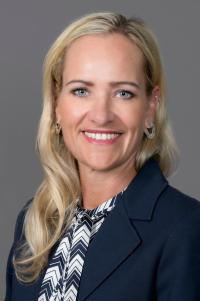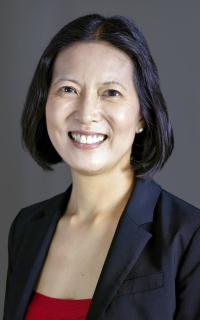
Meet the Division of Breast Imaging
A Conversation with Katja Pinker-Domenig and Janice Sung
Katja Pinker-Domenig, MD, PhD, and Janice Sung, MD, recently joined Columbia Radiology as chief and associate chief of the Division of Breast Imaging, overseeing a growing team of more than 12 subspecialized breast imaging radiologists in locations throughout Manhattan and Westchester. Pinker-Domenig and Sung are based in the Breast Imaging Center at Herbert Irving Pavilion, which serves the northern Manhattan community. We spoke to them about their first weeks at Columbia, their vision for the division, and what the future holds for breast cancer screening.
You’ve been at Columbia Radiology for exactly six weeks now. How is it going?
Pinker-Domenig: It has been an exciting start. We have been welcomed with open arms by literally everybody—surgeons, oncologists, and basically everybody we have been working with. It's a lot of movement, daily changes and challenges, but it is a great feeling.
Has anything surprised you?
Pinker-Domenig: I think the amount of support and positive energy here have actually surprised us in the best possible way.
Sung: Sometimes the goals of radiology are different from those of surgery or oncology. What really surprised me here is the collegiality, this feeling that we are a team with the same goal, and together we can work towards that. I think that's very special about Columbia.
With an almost entirely new team and a newly renovated, state-of-the-art Breast Imaging Center in northern Manhattan, it seems that you have a unique opportunity to really build something new here at Columbia. What is your vision for the Division of Breast Imaging?
Pinker-Domenig: The vision is a breast care center of the future, driven by information from all avenues. That means utilizing the whole breast imaging toolbox that is currently available to us, as well as the latest advances and research discoveries. In my opinion, clinical and research excellence are intertwined. Clinical excellence is the prerequisite and foundation to conduct high end research but with the idea to also translate, for example, the lessons learned from our risk-based screening research back into the clinics to provide best patient care. The vision is both clinical and research excellence, and I think our vision is not that far away.
Sung: It's a feedback mechanism. Clinical excellence drives the research, which leads to improving the clinical care not only for our patients here but ultimately to a broader population outside of Columbia.
What will risk-based screening look like for patients?
Pinker-Domenig: We know that no two patients are the same, so a one-size-fits-all concept for breast cancer screening doesn't work. We want to have precision imaging based on our patients—on their risk and their needs—and that is where a lot of research will be focused.
What research are you currently involved in?
Pinker-Domenig: There is a lot in the pipeline. We are continuing several existing lines of investigation and we have many other exciting new ideas for research projects that we can’t wait to get started on. I'm looking forward to doing a dive deep into advanced diffusion weighted imaging coupled with AI—basically the latest and greatest in diffusion weighted imaging and AI. We will also start contrast enhanced mammography research here. I am excited about closely collaborating with Dr. Despina Kontos and her Center for Innovation in Imaging Biomarkers and Integrated Diagnostics (CIMBID), because one of our main interests is the meaningful implementation of imaging biomarkers and AI.
Sung: Contrast enhanced mammography (CEM) is an imaging technique that continues to gain interest. CEM is far better than traditional mammography or ultrasound in detecting breast cancer and is almost as sensitive as breast MRI. Its main advantage is that it is far more affordable than MRI and is performed alongside the mammogram. This allows far more women to have access to a more effective screening test.
Tell me about the new team at the Herbert Irving Pavilion Breast Imaging Center.
Pinker-Domenig: We have a fantastic team. We are all breast experts, but everybody has their different interests. Dorothy (Sippo) is the vice chair of informatics. Janice is our associate division chief, but she’s also our expert in contrast-enhanced mammography. While my focus is MRI, this is such a broad field and our whole division will conquer and divide here. Roberto (Lo Gullo) will also be taking care of our international observers and research fellows who we will be welcoming. Nikki Bloch is the director of our breast imaging fellowship program, and we have Nahill (Matari), our designated educator, actively working on the resident curriculum. We’re looking forward to welcoming Delia Keating here, who will be the director of the Avon Breast Screening Center and quality control manager. Everybody has their niche, everybody excels in different areas, and we are capitalizing on that. I feel that delegation is the key to success, when you are delegating to the right people. I have a team here which is so excellent that delegation comes easy.
Your team also includes diagnostic radiology residents and a breast imaging fellow. Talk a little about the education mission of the division.
Sung: The residents that have come through our service are fantastic. They are smart, eager to learn, and wonderful to work with. We’re doing some restructuring and organizing, but education will be a focus of the division.
Pinker-Domenig: It’s fantastic that we have our fellow, and so many residents rotating through our division. I think we offer a stellar breast teaching curriculum that can only improve with all the expertise we have on board here.
There is a lot happening in the realm of breast cancer prevention and screening, and it’s clear that Columbia is poised to be a leader in this area. What are you excited about?
Sung: It's very exciting times in breast imaging right now. For a long time, breast imaging was somewhat stagnant. There were small improvements, like moving from film to digital mammography and then to tomosynthesis. But it's really in the past 10 years or so that we've had this explosion of so many other available tools, such as ultrasound and MRI, abbreviated breast MRI, and contrast-enhanced mammogram. We are really just starting to explore how to best utilize these tools to optimize breast imaging for all our patients.
Pinker-Domenig: The future of breast cancer screening is bright. There are still open questions and there are a lot of smart people around the world working on it. I do not think that we will provide the ultimate answers alone. There will be multi-site collaborations with partners across the globe to provide these. We share a common goal: we want to offer our patients the highest possible standard of care through the meaningful use of the many tools that we have in our breast imaging toolbox and rapid implementation of latest research findings in the clinics.
References
More Information
Faculty in Division of Breast Imaging in the Department of Radiology:
- Rebecca Alis, MD
- Nicolas Bloch, MD
- Marc Brown, MD
- Celin Chacko, MD
- Lynn Chinitz, MD
- Delia Keating, MD
- Tova Koenigsberg, MD
- Roberto Lo Gullo, MD
- Nahill Matari, MD
- Dorothy Sippo, MD, MPH
- Marcy Susman, MD


